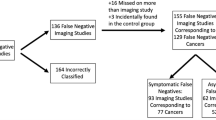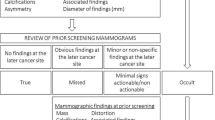Abstract
Purpose
Our study addresses at the benefit of surveillance of probably benign lesions, detected outside mammographic screening, during a 3-year period.
Methods
28,588 women (mean age 57 ± 12 years) were examined. Two independent radiologists read the mammogram as well as the supplemented ultrasound (in case of breast density ACR type 3 and 4). In the case of discordance a third expert considered whether further examination was indicated or not.
Results
3,266 diagnostic procedures ended with BI-RADS 3 result and 2,512 (76.9 %) women underwent a follow-up examination. 295 (11.7 %) of them received assessment examination (imaging and/or biopsy) and 37 (12.5 %) (none of them palpable) ended with BI-RADS 6. This equals a tumor detection rate of 14.7/1,000. The ratio in situ:invasive was 7:10 (1:1.43) and the mean size was 11.1 ± 4.51 mm. In the total cohort, 536 carcinomas ended with BI-RADS 6 of them 17 % were in situ and 83 % were invasive breast cancers (ratio in situ:invasive 1:4.99), mean size was 13.8 ± 6.3 mm. The cancer detection ratio in these cases was 18.7/1,000.
Conclusions
The amount of detected tumors at follow-up of women with preceding BI-RADS 3 equates the associated potential of malignancy.


Similar content being viewed by others
Abbreviations
- BI-RADS:
-
Breast imaging reporting and data system
- ACR:
-
American College of Radiology
- RBCP:
-
Regional breast care project
- ADH:
-
Atypical ductal hyperplasia
- LIN:
-
Lobular intra-epithelial neoplasia
- QuaMaDi:
-
Local quality-assured breast diagnostics program
References
American College of Radiology (1998) Breast imaging reporting and data system (BI-RADS), 3rd edn. American College of Radiology, Raston, pp 94–95
Lehman C, Holt S, Peacock S, White E, Urban N (2002) Use of the American college of radiology BI-RADS guidelines by community radiologists: concordance of assessments and recommendations assigned to screening mammograms. AJR 179:15–20
Caplan LS, Blackman D, Nadel M, Monticciolo DL (1999) Coding mammograms using the classification ‘probably benign finding: short interval follow-up suggested’. AJR 172:339–342
Sickles EA (1999) Probably benign breast lesions: when should follow-up be recommended and what is the optimal follow-up protocol? Radiology 213:11–14
Sickles EA (1995) Management of probably benign breast lesions. Radiol Clin North Am 33:1123–1130
Sickles EA (1991) Periodic mammographic follow-up of probably benign lesions: results in 3,184 consecutive cases. Radiology 179:463–468
Varas X, Leborgne F, Leborgne JH (1992) Non palpable, probably benign lesions: role of follow-up mammography. Radiology 184:409–414
Helvie MA, Pennes DR, Rebner M, Adler DD (1991) Mammographic follow-up of low-suspicion lesions: compliance rate and diagnostic yield. Radiology 178:155–158
Varas X, Leborgne JH, Leborgne F, Mezzera J, Jaumandreu S, Leborgne F (2002) Revisiting the mammographic follow-up of BI:RADS category 3 lesions. AJR 179:691–695
Vizcaíno I, Gadea L, Andreo L, Salas D, Ruiz-Perales F, Cuenas D, Herranz C, Bueno F, Screening Program Working Group (2001) Short-term follow-up results in 795 nonpalpable probably benign lesions detected at screening mammography. Radiology 219:475–483
Burnside ES, Sickles EA, Bassett LW et al (2009) The ACR BI-RADS® experience: learning from history. J Am Coll Radiol 6:851–860
Adler DD, Helvie MA, Ikeda DM (1990) Nonpalpable probably benign breast lesions: follow-up strategies after initial detection on mammography. AJR 155:1195–1201
EUREF European Guidelines for Quality Assurance in Mammography Screening (2001). European Commission, Luxembourg
EUREF European Guidelines for Quality Assurance in Mammography Screening and Diagnosis (2006). European Commission, Luxembourg
Katalinic A, Bartel C, Raspe H, Shreer I (2007) Beyond mammography screening: quality assurance in breast cancer diagnosis (The QuaMaDi Project). Br J Cancer 96:157–161
Schreer I, Katalinic A (2007) Is high quality breast imaging and diagnosis possible in a decentralized system?. The QuaMaDi project. Breast Care 2:20–24
Albert U-S, Altland H, Duda V et al (2008) Summary of the updated stage 3 guideline for early detection of breast cancer in Germany 2008. Fortschr Röntgenstr 180:455–465
D’Orsi CJ (1992) To follow or not to follow, that is the question. Radiology 184:306
Rubin E (1999) Six-month follow-up: an alternative view (viewpoint). Radiology 213:15–18
Hall FM (2002) Malignancy in BI-RADS category 3 mammographic lesions (letter). Radiology 225:918–920
Baum JK, Hanna LG, Acharyya S, Mahoney MC, Conant EF, Basset LW, Pisano ED (2011) Use of BI-RADS 3 probably benign category in the American college of radiology imaging network digital mammographic imaging screening trial. Radiology 260(1):61–67
Meyer JE, Kopans DB (1981) Stability of a mammographic mass: a false sense of security. AJR 137:595–598
Liberman L, La Trenta LR, Dershaw DD, Abramson AF, Morris EA, Cohen MA, Rosen PP, Borgen PI (1997) Impact of core biopsy on the surgical management of impalpable breast cancer. AJR 168:495–499
Acknowledgments
First of all, we want to thank the patients for their participation in QuaMaDi program and for their compliance to the periodic surveillance examinations. This publication is a teamwork of 250 people (including doctors and medical staff, as well as the personnel of the Institute of Cancer Epidemiology of the University of Lübeck), who are involved in QuaMaDi project in Schleswig–Holstein. We also thank the participating health care insurance companies, the Ministry of Social Affairs and Health and the Deutsche Krebshilfe e. V., who have financed the program.
Conflict of interest
None.
Author information
Authors and Affiliations
Corresponding author
Rights and permissions
About this article
Cite this article
Kapsimalakou, S., Waldmann, A., Katalinic, A. et al. Follow-up of probably benign lesions in non-screening breast diagnostics. Arch Gynecol Obstet 290, 543–551 (2014). https://doi.org/10.1007/s00404-014-3233-5
Received:
Accepted:
Published:
Issue Date:
DOI: https://doi.org/10.1007/s00404-014-3233-5




